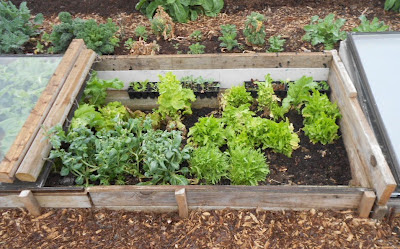The nice thing about having a blog site is that it so easily allows me to mix photos and text to keep track of my own gardening progress. So next year I will be able to go back to today's blog and see that I could probably have planted fava beans and peas a bit earlier. Fava beans are not your usual bush bean, and can take quite a bit of cold. I am still learning about favas, including the need to seek out great recipes. Favas are also known as broad beans.
 |
| Fava Bean Starts, 3/21/2012 |
The plot size at the park is 20 ft by 40 feet. Gardens are laid out in two plot parcels, so there is a path on three sides of my plot, while the left border abuts my neighbor's garden. He tills his garden, but can't get right next to my permanent stakes. Thus a weedy strip grows between the gardens, which means that the weeds ultimately send raiding parties into my plot. So about a week ago, I dug out the weeds, and mounded up the border with mushroom soil. And since I have very little open space in which to plant, this seemed the perfect place to plant the fava bean starts.

While digging out the weeds, I came upon many nice grass clumps. They were headed for the compost pile, but I put them in the truck instead. They will be used to patch some bare areas in the lawn at home. Wish I had many more clumps.
Here you can see the beans a little more clearly. They are planted directly in the mushroom soil, so I hope that will not be a problem. The fava bean plants get to be a bush, easily two to three feet high. The aphids certainly like fava foliage and stems, but don't seem to be a big problem, as the volunteer ladybugs soon find the bed a great place to find tasty tidbits.
Ah, another spot not close to onions. This bed is for the english podded peas, name unknown as I had not labeled the bag of bulk seeds. Years ago I had sworn off growing podded peas, as they take a lot of space to get a worthwhile harvest. But I planted some two years ago to use up some seed, and they were sooo delicious when eaten raw like peanuts, that I was a convert. I will still plant some snap peas and snow peas, but the podded peas are worth some space.
 |
| English Podded Peas, 3/21/2012 |
In this picture, you can see the peas on the bed. I tried to drop two peas at about five inch spacing. Then I went along with a long pole to push them into the bed, thus not having to bend over or plant from a kneeling position. I am sure the peas didn't care that I avoided a sore back. Hope they don't mind getting started in the straight mushroom soil top dressing.
These last two pictures were taken yesterday just for archive purposes:
The plants above are Tango Lettuce that overwintered without any protection. Where they were crowded, I dug out a plant or two and replanted them with more leg room. Yep, then added more mushroom soil as a side dressing.
This is a shot of one of the cold frames showing lettuce and tatsoi. Those few empty spots were filled in yesterday with new lettuce starts. And mushroom soil for good measure.

















































